August 24, 2015
BURLINGTON, ON
City council has decided that the completion of the Official Plan Review (OPR) will not get done until the Strategic Plan has been completed – the rub with that decision is that at the rate the Strategic Plan is going it may not be seen until sometime in 2016.
Council has some critical issues it must make decisions on – the budget has to get done, there are some key hiring decisions to be made and the significant seven that lead the city have to decide if they are going to manage to get along any better now that they have all had a vacation. Don’t bet on the latter.
The Committee of the Whole, which is the Standing Committee that is shepherding the Strategic Plan to its completion, isn’t going to meet until sometime in the middle of October – and the amount of data that the consultants hired to help with the creation of the plan are going to dump on the table could choke a horse.
The amount of research is staggering. We will get into that in a paragraph or two – what is disturbing is that when Council approved the research assignment the man charged with the responsibility of bringing jobs to the city wasn’t in the room.
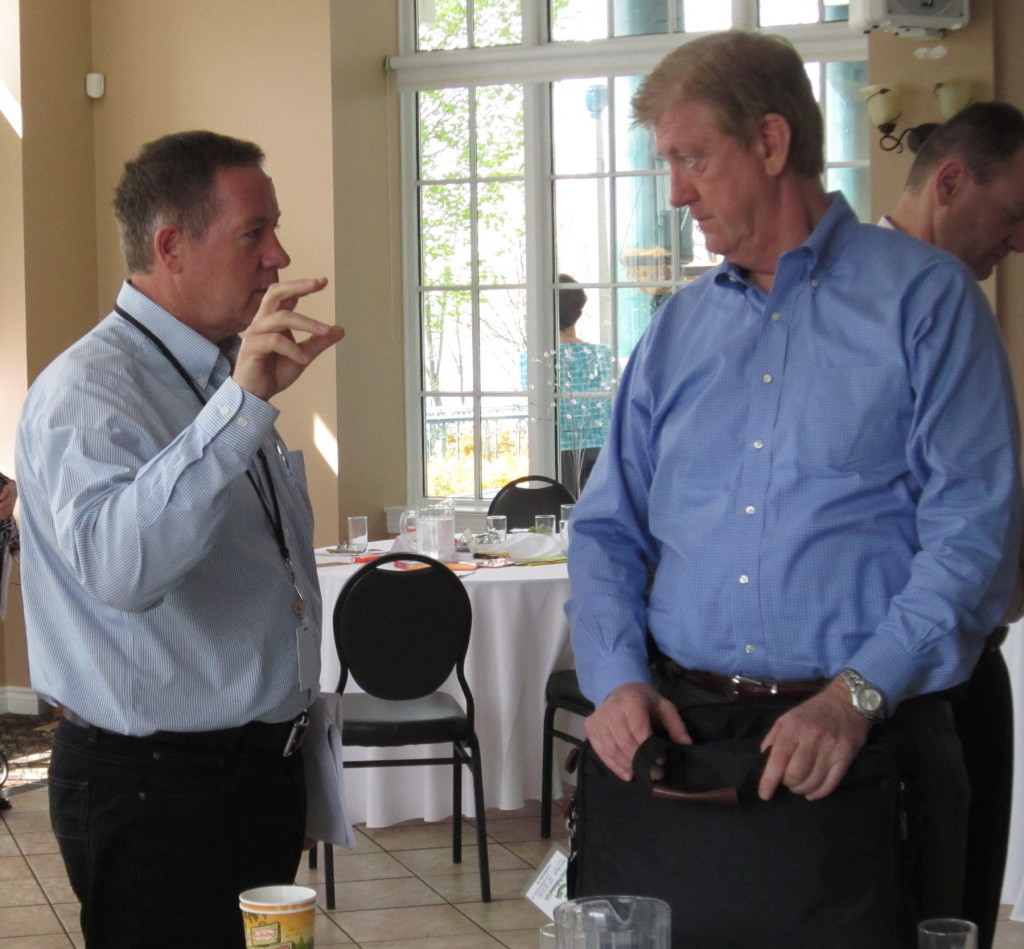
Frank McKeown, on the left explains a concept to Councillor Paul Sharman during the creation of the Strategic Plan in 2011.
Frank McKeown, executive director of the Burlington Economic Development Corporation, (EDC) didn’t learn of the meeting date until a few days before it was to take place and he didn’t have a copy of the agenda – he had no idea how much research work the city had asked for. A lot of what was being asked for had already been done by McKeon and his organization.
McKeown intends to eventually scrub the data he has collected and post it on the EDC web site for anyone to see and use. Any self-respecting economic development department would do that. Quite why Burlington has hired someone to ask all these questions boggles the mind a bit – don’t we already have that information?
The left pocket clearly wasn’t talking to the right pocket – odd because everyone at city hall knows who McKeown is and have a high regard for the quality of his thinking and the manner in which he closes files and gets things done.
McKeown was the Mayor’s Chief of Staff for two years. He threw in that towel when he found that city hall wasn’t the kind of place where a lot of real work got done. Not because of the people doing the work – it was a leadership issue for McKeown – there wasn’t all that much of it.
There are several who are asking if all this work being done to put a Strategic Plan in place makes any sense. Ward 1 Councillor Rick Craven thinks that what was created in 2011 is just fine – he’d go with that – but his view apparently isn’t shared by the rest of council.
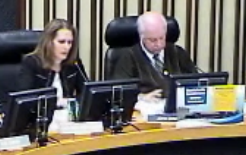
Councillors Meed Ward and Taylor tend to ask a lot of questions and are open to making the process more open. Taylor once threatened to walk out of Council and talk publicly about a report the majority of Council wanted to keep confidential.
Councillor Meed Ward finds herself asking if the Strategic Plan needs just a refresh or does the city need a full reboot on what they created in 2011.
The ward two councilor was in an auto accident and was not able to take part in a number of standing committee meetings – including two that were critical – the first look at the draft of a Master Transportation Plan and the meeting at which the KPMG Strategic Plan assignment was threshed out and agreed upon.
The auto accident resulted in some serious concussion damage from which Meed Ward says she is recovering nicely and expects to be in fine form when Council resumes its work in September.
The research assignment sets out five major hypothesis: one labelled Economic, then 2 – Land Use Planning and the Built Environment, 3 – Demographics, Growth and Health, 4 – City Operations, Governance and Powers and 5 – Culture
A Primary hypothesis is examined along with several subsidiary hypothesis and the question the researchers would focus on. There were some pretty heavy duty questions asked.
Two concerns jump out: why is this level of work being done at this stage – should have been done at least six months ago – and when you look at the questions one is moved to ask: Don’t we already know the answers to these questions.
The KPMG approach argues that 1 – Trade-offs shape strategy, 2 – Strategy involves choosing among incompatible alternatives, each of which is attractive, 3 – Failure to choose puts the organization in a situation of becoming “stuck in the middle” and 4 – Straddling problems stymie the success of a clear strategy.
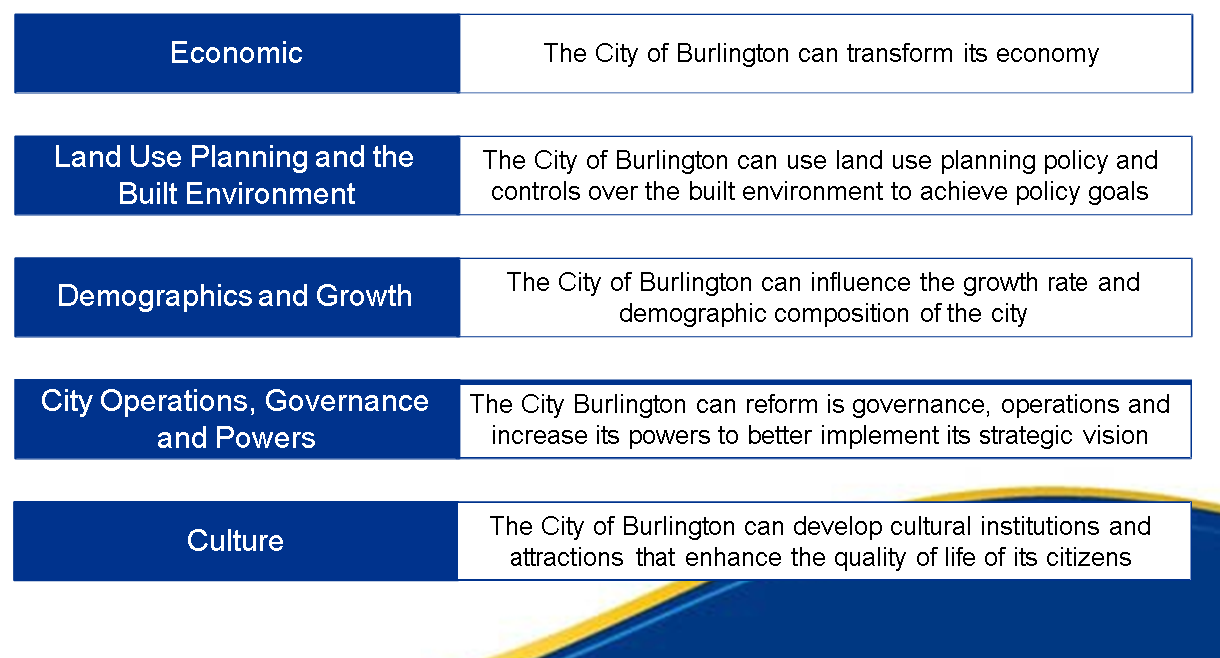
The city hired consultants to take a deep (which means expensive) look into five areas: The economy; Land Use Planning and the |Built environment, demographics and Growth, City operations, governance and Powers and Culture.
The KPMG approach to problem solving includes:
1. Focus analysis around key hypotheses
2. Triangulate around difficult problems to identify the right strategic levers
3. Keep analytical priorities aligned with key hypotheses
4. Manage precision of analysis to account for economies of effort.
Here is the Economic: Principal Hypothesis: The City of Burlington can transform its economy.
Q: What are the principal economic trends of the City of Burlington?
Q: What are the principal economic trends in the region?
Q: What are the relative economic attributes of the City of Burlington?
Q: What are the key policy levers that can be deployed and the materiality of their effect on economic outcomes?
Subsidiary Hypothesis: The City of Burlington can repatriate jobs and careers to within the City boundaries.
Q: What is the geography of employment for residents of the city?
Q: What is the current labor force composition of the city?
Q: What are the policy levers that can change the location of careers and jobs in the context of the regional economy?
Subsidiary Hypothesis: The City of Burlington can create more good paying jobs for Burlington youth
Q: What are the policy levers that can promote jobs and careers that keep younger residents in the City of Burlington?
Q: What is the current employment profile of ‘youth’ in the City of Burlington?
Q: What is the job trajectory for GTA youth over the short, medium and long-term?
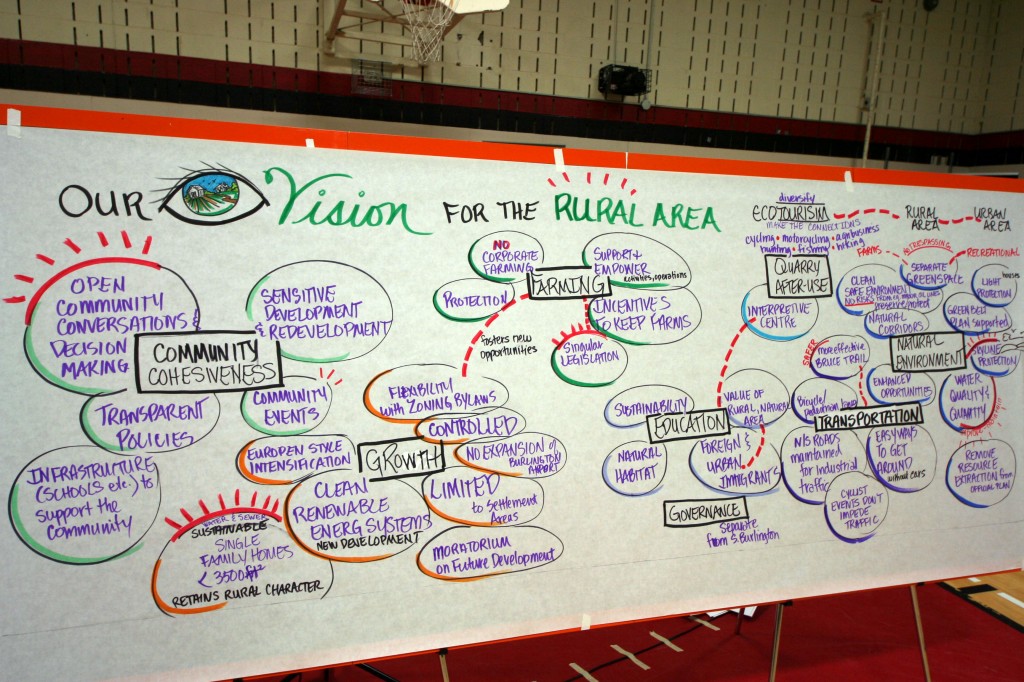
It was about 15 months ago that rural Burlington began the discussion about what it wanted to be. Some things were clear – others not as clear. The early draft of a vision got put on a huge board and for the most part the community liked the look of what they had said to each other. Will this kind of data find its way into the hands of the consultants helping the city work up its Strategic Plan.
Subsidiary Hypothesis: The City of Burlington can promote and integrate the rural economy within its boundaries.
Q: What are the current characteristics of the rural economy?
Q: What is the likely trajectory of the rural economy in this region in the short, medium and long-term.
Q: What are the key regional institutions that could play a role in developing the City’s regional rural economy?
Q: What are the key policy levers the can affect the rural economy?
Subsidiary Hypothesis: The City of Burlington can help create an “innovation economy”
Q: How have other municipal jurisdictions created the conditions for an innovation based economy?
Q: What are the key characteristics of an innovation based economy?
Q: What are the policy levers that Burlington can deploy to create such an economy?
Principle hypothesis: City Operations, Governance and Powers:
The City of Burlington can reform is governance, operations and increase its powers to better implement its strategic vision,
Q: What are the key areas where the City of Burlington does not have the appropriate discretion to implement policies?
Q: How does, and in which areas does provincial policy constrain the City of Burlington?
Q: How does relationship with neighboring municipalities enhance or constrain the City’s ability to deliver services for its population?
Subsidiary Hypothesis: The City can deliver services in a more efficient and effective manner.
Q: What are the current challenges of service delivery?
Q: What are the different models that could be used to administer the city and deliver services more effectively?
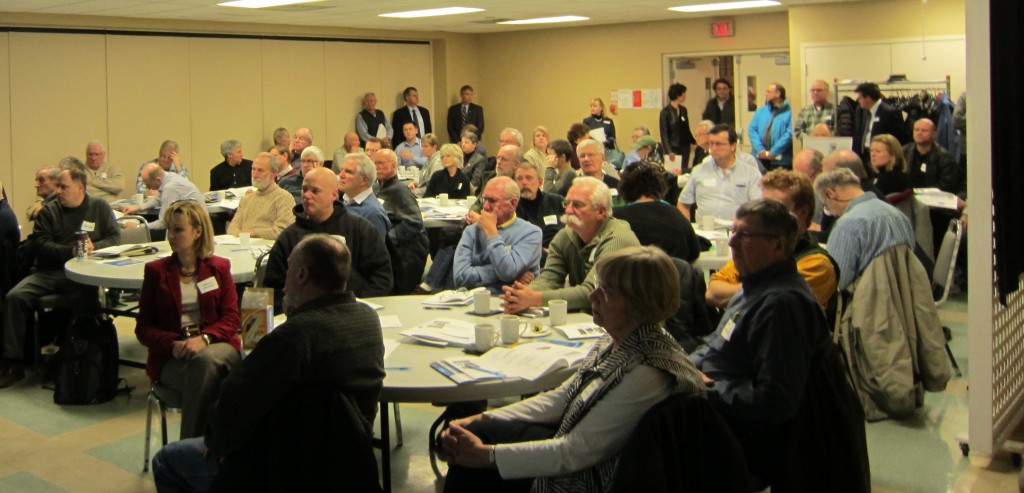
A rapt audience listened to an overview of a city budget. What they did was listen to what the city had already decided to do. Is there a better way to involve the public.
Subsidiary Hypothesis: The City can incorporate its citizen’s into decision making and program delivery in a more effective manner.
Q: How have other jurisdictions incorporated citizens better into government decision making and policy delivery?
Subsidiary hypothesis: The city can increase its financial capacity to deliver services invest in infrastructure or cut taxes
Q: How much of the City of Burlington’s spending is discretionary in the short, medium and long-term?
Q: What is the revenue mix of the City over the short, medium and long-term?
Q: What are the current revenue levers?
Q: Are there innovative ways to fund, finance and deliver services being deployed in other jurisdictions that could be used by the City?
Subsidiary Hypothesis: The City can find innovative ways to fund, finance and deliver infrastructure.
Q: What are the infrastructure challenge that are not matched with the correct infrastructure financing, funding, delivery and maintenance tools?
Q: What are the key infrastructure needs that are not being addressed in the short, medium and long-term?
Q: The current provincial planning regime is impeding economic growth in the province?
Q: Value can be unlocked from municipal assets to fund strategic priorities?
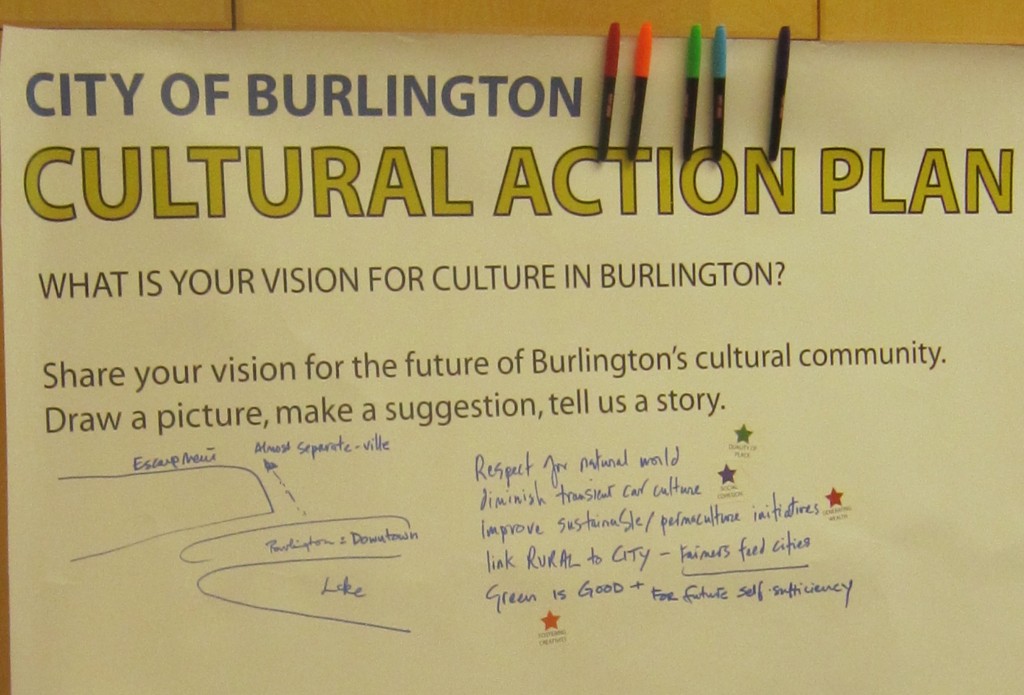
A lot of research has been done on how to make culture a more vital part of the community. Research not withstanding there are still some really stupid cultural decisions being made.
Principal Hypothesis: Culture – The City of Burlington can develop cultural institutions and attractions that enhance the quality of life of its citizens.
Q: What are the current cultural institutions and their level of popularity?
Q: What are the current and nascent cultural endowments of the City?
Q: What are the mechanisms through which the City can support and grow an impactful cultural community?
There are three other areas that were to be given the KPMG research treatment. McKeown will be meeting with that crew in February – expect to see some changes.
McKeown should have been in the room for that June meeting. Who slipped up on telling him about the meeting?

















Frank left the Mayors office because “staff don’t want to do anything” was the way I heard it personally.
Or as Pepper put it, “that city hall wasn’t the kind of place where a lot of real work got done. Not because of the people doing the work – it was a leadership issue for McKeown – there wasn’t all that much of it.”
Given this situation, why should there be any wonder about why Frank was not kept in the loop by city managers? That would have taken a little intelligent thought to step outside the ego silo, so we see the null result of its absence.
The new City Manager has his work cut out for him for sure. He really needs to make everyone visibly and publically accountable in a transparent and concrete way.
My experience with the city managers is one of non-responsiveness and no accountability. I have lots of it if anyone wants to know.